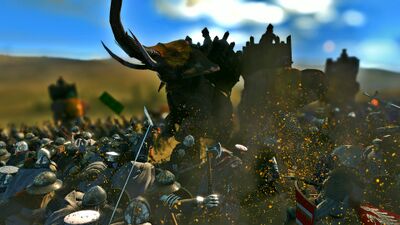Symmerian-Ridevan War: Difference between revisions
No edit summary |
m (Tyrone moved page Makedonian-Ridevan War to Symmerian-Ridevan War) |
Revision as of 16:48, 6 February 2022
| Makedonian-Ridevan War | |||||||
|---|---|---|---|---|---|---|---|
 Ridevan elephants clash with Makedonian infantry. | |||||||
| |||||||
| Belligerents | |||||||
|
|
| ||||||
| Commanders and leaders | |||||||
|
|
| ||||||
| Units involved | |||||||
| Ridevan military | Ancient Makedonian army | ||||||
| Strength | |||||||
| Hundreds of thousands | Hundreds of thousands | ||||||
| Casualties and losses | |||||||
| Heavy | Heavy | ||||||
The Makedonian-Ridevan War was a conflict fought between the Makedonian Empire and the Rideva Empire from 1148 to 1161. The war begin as a result of disputes between Makedon and Rideva over Knichus, which both empire's held territory in, and ended in a Ridevan victory that ended Makedonian influence in south-east Siduri.
The origin of the war lay in the aftermath of the Âu Lạc Rebellion, which resulted in the secession of Quenmin from Makedonian dominion. The loss of such a large province, and the supply of tribute and manpower Makedonian Quenmin had provided, severely weakened Makedonian influence in south-east Siduri. As a result the Makedonians began extracting larger sums of tribute and taxation from their eastern domains to cover the loss of Quenmin, stressing the already tenuous Makedonian grip in Knichus and Mulajhyra. Makedonian demands eventually resulted in the outbreak of unrest across the region, which overflowed into the Ridevan province of Krsnavamandala. Ridevan efforts to repress the rebellious strife spilling over into Krsnavamandala triggered Makedonian reprisals, who feared Ridevan desires to annex all of Knichus, leading to the outbreak of fighting in 1148.
The first several years of the conflict were marked by few exchanges of territory amid a strategic stalemate with neither power willing to undertake a major invasion of the other. The highly professional Ridevan military, arguably the most powerful the Makedonians had ever faced, fielded large quantities of cavalry and elite infantry that the mass conscripted armies of Makedon were poorly suited to face. By 1156 the increasing demands of the Makedonians drove large scale defections from the Sidi and Condottiero populations towards the Ridevan side, crippling the Makedonian presence in Knichus. A subsequent Ridevan invasion drove the Makedonians out of Knichus and Mulajhyra in 1157. A Makedonian army under Bahlindov was able to cross the central Siduri steppe and retake Mulajhyra, but was defeated in Knichus. A Makedonian invasion of Khaltia in 1159 briefly threatened Tennai itself before it too was defeated in 1161, after which the Makedonians sued for peace.
The war cost the Makedonians control of Knichus and Mulajhyra and ended the 500 year long Makedonian presence in south-east Siduri. The war also made clear the decline of Makedonian military prowess and identified the Rideva Empire as the premier military power in Siduri. The war's end also effectively ended any Makedonian hopes of re-asserting control over eastern Siduri, in particular Quenmin. The defeat would also galvanize further rebellions against the Makedonians, in particular the Rawwadid Sultunate and its campaigns to rid Mansuriyyah of Makedonian influence. Despite it's victory the cost of the war depleted the Ridevan treasury, and would enter into decline during the 13th Century.